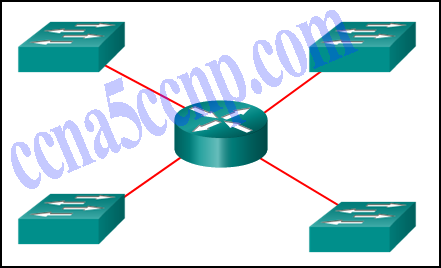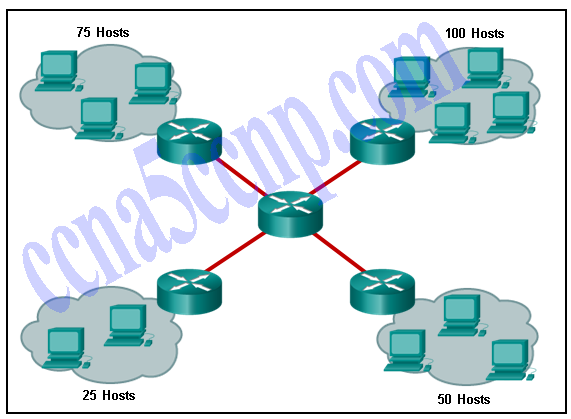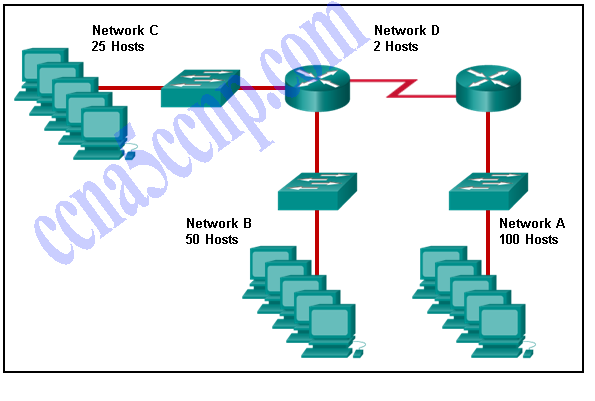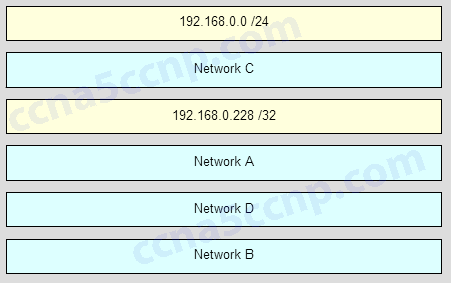Last Updated on March 3, 2019 by Admin
ITN CCNA 1 v6.0 Chapter 8 Exam Answers 2018 2019 (100%)
Cisco CCNA 1 ITN v6.0 chapter 8 Exam Answers Routing and Switching (R&S) Introduction to Networks (ITN) (Version 6.00) collection year 2017, 2018 and 2019 Full 100%. CCNA 1 has been know as ITN. The following are the questions exam answers. Guarantee Passed 100%. CCNA 1 v6.0 chapter 8 exam answers has some new update from the old version 5.1. You can review all chapter 8 Exam Answers. You will get passed scored 100% with this version 6.0. Good Luck for Cisco Netacad ITN v6.0 Exam!
From year to year, Cisco has updated many versions with difference questions. The latest version is version 6.0 in 2018. What is your version? It depends on your instructor creating your class. We recommend you to go thought all version if you are not clear. While you take online test with netacad.com, You may get random questions from all version. Each version have 1 to 10 different questions or more. After you review all questions, You should practice with our online test system by go to "Online Test" link below.
-
What is a result of connecting two or more switches together?
- The number of broadcast domains is increased.
- The size of the broadcast domain is increased.
- The number of collision domains is reduced.
- The size of the collision domain is increased.
Explanation: When two or more switches are connected together, the size of the broadcast domain is increased and so is the number of collision domains. The number of broadcast domains is increased only when routers are added.
-
Refer to the exhibit. How many broadcast domains are there?
- 1
- 2
- 3
- 4
Explanation: A router is used to route traffic between different networks. Broadcast traffic is not permitted to cross the router and therefore will be contained within the respective subnets where it originated.
-
What are two reasons a network administrator might want to create subnets? (Choose two.)
- simplifies network design
- improves network performance
- easier to implement security policies
- reduction in number of routers needed
- reduction in number of switches needed
Explanation: Two reasons for creating subnets include reduction of overall network traffic and improvement of network performance. Subnets also allow an administrator to implement subnet-based security policies. The number of routers or switches is not affected. Subnets do not simplify network design.
-
Refer to the exhibit. A company uses the address block of 128.107.0.0/16 for its network. What subnet mask would provide the maximum number of equal size subnets while providing enough host addresses for each subnet in the exhibit?
- 255.255.255.0
- 255.255.255.128
- 255.255.255.192
- 255.255.255.224
- 255.255.255.240
Explanation: The largest subnet in the topology has 100 hosts in it so the subnet mask must have at least 7 host bits in it (27-2=126). 255.255.255.0 has 8 hosts bits, but this does not meet the requirement of providing the maximum number of subnets.
-
Refer to the exhibit. The network administrator has assigned the LAN of LBMISS an address range of 192.168.10.0. This address range has been subnetted using a /29 prefix. In order to accommodate a new building, the technician has decided to use the fifth subnet for configuring the new network (subnet zero is the first subnet). By company policies, the router interface is always assigned the first usable host address and the workgroup server is given the last usable host address. Which configuration should be entered into the properties of the workgroup server to allow connectivity to the Internet?
- IP address: 192.168.10.65 subnet mask: 255.255.255.240, default gateway: 192.168.10.76
- IP address: 192.168.10.38 subnet mask: 255.255.255.240, default gateway: 192.168.10.33
- IP address: 192.168.10.38 subnet mask: 255.255.255.248, default gateway: 192.168.10.33
- IP address: 192.168.10.41 subnet mask: 255.255.255.248, default gateway: 192.168.10.46
- IP address: 192.168.10.254 subnet mask: 255.255.255.0, default gateway: 192.168.10.1
Explanation: Using a /29 prefix to subnet 192.168.10.0 results in subnets that increment by 8:
192.168.10.0 (1)
192.168.10.8 (2)
192.168.10.16 (3)
192.168.10.24 (4)
192.168.10.32 (5)
-
If a network device has a mask of /28, how many IP addresses are available for hosts on this network?
- 256
- 254
- 62
- 32
- 16
- 14
Explanation: A /28 mask is the same as 255.255.255.240. This leaves 4 host bits. With 4 host bits, 16 IP addresses are possible, but one address represents the subnet number and one address represents the broadcast address. 14 addresses can then be used to assign to network devices.
-
Which subnet mask would be used if 5 host bits are available?
- 255.255.255.0
- 255.255.255.128
- 255.255.255.224
- 255.255.255.240
Explanation: The subnet mask of 255.255.255.0 has 8 host bits. The mask of 255.255.255.128 results in 7 host bits. The mask of 255.255.255.224 has 5 host bits. Finally, 255.255.255.240 represents 4 host bits.
-
How many host addresses are available on the network 172.16.128.0 with a subnet mask of 255.255.252.0?
- 510
- 512
- 1022
- 1024
- 2046
- 2048
Explanation: A mask of 255.255.252.0 is equal to a prefix of /22. A /22 prefix provides 22 bits for the network portion and leaves 10 bits for the host portion. The 10 bits in the host portion will provide 1022 usable IP addresses (210 – 2 = 1022).
-
How many bits must be borrowed from the host portion of an address to accommodate a router with five connected networks?
- two
- three
- four
- five
Explanation: Each network that is directly connected to an interface on a router requires its own subnet. The formula 2n, where n is the number of bits borrowed, is used to calculate the available number of subnets when borrowing a specific number of bits.
-
A network administrator wants to have the same network mask for all networks at a particular small site. The site has the following networks and number of devices:
IP phones – 22 addresses
PCs – 20 addresses needed
Printers – 2 addresses needed
Scanners – 2 addresses neededThe network administrator has deemed that 192.168.10.0/24 is to be the network used at this site. Which single subnet mask would make the most efficient use of the available addresses to use for the four subnetworks?
- 255.255.255.0
- 255.255.255.192
- 255.255.255.224
- 255.255.255.240
- 255.255.255.248
- 255.255.255.252
Explanation: If the same mask is to be used, then the network with the most hosts must be examined for the number of hosts, which in this case is 22 hosts. Thus, 5 host bits are needed. The /27 or 255.255.255.224 subnet mask would be appropriate to use for these networks.
-
A company has a network address of 192.168.1.64 with a subnet mask of 255.255.255.192. The company wants to create two subnetworks that would contain 10 hosts and 18 hosts respectively. Which two networks would achieve that? (Choose two.)
- 192.168.1.16/28
- 192.168.1.64/27
- 192.168.1.128/27
- 192.168.1.96/28
- 192.168.1.192/28
Explanation: Subnet 192.168.1.64 /27 has 5 bits that are allocated for host addresses and therefore will be able to support 32 addresses, but only 30 valid host IP addresses. Subnet 192.168.1.96/28 has 4 bits for host addresses and will be able to support 16 addresses, but only 14 valid host IP addresses.
-
A network administrator is variably subnetting a network. The smallest subnet has a mask of 255.255.255.248. How many usable host addresses will this subnet provide?
- 4
- 6
- 8
- 10
- 12
Explanation: The mask 255.255.255.248 is equivalent to the /29 prefix. This leaves 3 bits for hosts, providing a total of 6 usable IP addresses (23 = 8 – 2 = 6).
-
Refer to the exhibit.
Given the network address of 192.168.5.0 and a subnet mask of 255.255.255.224, how many total host addresses are unused in the assigned subnets?
- 56
- 60
- 64
- 68
- 72
Explanation: The network IP address 192.168.5.0 with a subnet mask of 255.255.255.224 provides 30 usable IP addresses for each subnet. Subnet A needs 30 host addresses. There are no addresses wasted. Subnet B uses 2 of the 30 available IP addresses, because it is a serial link. Consequently, it wastes 28 addresses. Likewise, subnet C wastes 28 addresses. Subnet D needs 14 addresses, so it wastes 16 addresses. The total wasted addresses are 0+28+28+16=72 addresses.
-
Refer to the exhibit. Considering the addresses already used and having to remain within the 10.16.10.0/24 network range, which subnet address could be assigned to the network containing 25 hosts?
- 10.16.10.160/26
- 10.16.10.128/28
- 10.16.10.64/27
- 10.16.10.224/26
- 10.16.10.240/27
- 10.16.10.240/28
Explanation: Addresses 10.16.10.0 through 10.16.10.63 are taken for the leftmost network. Addresses 10.16.10.192 through 10.16.10.207 are used by the center network.The address space from 208-255 assumes a /28 mask, which does not allow enough host bits to accommodate 25 host addresses.The address ranges that are available include 10.16.10.64/26 and10.16.10.128/26. To accommodate 25 hosts, 5 host bits are needed, so a /27 mask is necessary. Four possible /27 subnets could be created from the available addresses between 10.16.10.64 and 10.16.10.191:
10.16.10.64/27
10.16.10.96/27
10.16.10.128/27
10.16.10.160/27
-
A network administrator needs to monitor network traffic to and from servers in a data center. Which features of an IP addressing scheme should be applied to these devices?
- random static addresses to improve security
- addresses from different subnets for redundancy
- predictable static IP addresses for easier identification
- dynamic addresses to reduce the probability of duplicate addresses
Explanation: When monitoring servers, a network administrator needs to be able to quickly identify them. Using a predictable static addressing scheme for these devices makes them easier to identify. Server security, redundancy, and duplication of addresses are not features of an IP addressing scheme.
-
Which two reasons generally make DHCP the preferred method of assigning IP addresses to hosts on large networks? (Choose two.)
- It eliminates most address configuration errors.
- It ensures that addresses are only applied to devices that require a permanent address.
- It guarantees that every device that needs an address will get one.
- It provides an address only to devices that are authorized to be connected to the network.
- It reduces the burden on network support staff.
Explanation: DHCP is generally the preferred method of assigning IP addresses to hosts on large networks because it reduces the burden on network support staff and virtually eliminates entry errors. However, DHCP itself does not discriminate between authorized and unauthorized devices and will assign configuration parameters to all requesting devices. DHCP servers are usually configured to assign addresses from a subnet range, so there is no guarantee that every device that needs an address will get one.
-
A DHCP server is used to assign IP addresses dynamically to the hosts on a network. The address pool is configured with 192.168.10.0/24. There are 3 printers on this network that need to use reserved static IP addresses from the pool. How many IP addresses in the pool are left to be assigned to other hosts?
- 254
- 251
- 252
- 253
Explanation: If the block of addresses allocated to the pool is 192.168.10.0/24, there are 254 IP addresses to be assigned to hosts on the network. As there are 3 printers which need to have their addresses assigned statically, then there are 251 IP addresses left for assignment.
-
Refer to the exhibit. A company is deploying an IPv6 addressing scheme for its network. The company design document indicates that the subnet portion of the IPv6 addresses is used for the new hierarchical network design, with the site subsection to represent multiple geographical sites of the company, the sub-site section to represent multiple campuses at each site, and the subnet section to indicate each network segment separated by routers. With such a scheme, what is the maximum number of subnets achieved per sub-site?
- 0
- 4
- 16
- 256
Explanation: Because only one hexadecimal character is used to represent the subnet, that one character can represent 16 different values 0 through F.
-
What is the prefix for the host address 2001:DB8:BC15:A:12AB::1/64?
- 2001:DB8:BC15
- 2001:DB8:BC15:A
- 2001:DB8:BC15:A:1
- 2001:DB8:BC15:A:12
Explanation: The network portion, or prefix, of an IPv6 address is identified through the prefix length. A /64 prefix length indicates that the first 64 bits of the IPv6 address is the network portion. Hence the prefix is 2001:DB8:BC15:A.
-
Consider the following range of addresses:
2001:0DB8:BC15:00A0:0000::
2001:0DB8:BC15:00A1:0000::
2001:0DB8:BC15:00A2:0000::
…
2001:0DB8:BC15:00AF:0000::
The prefix-length for the range of addresses is /60
Explanation: All the addresses have the part 2001:0DB8:BC15:00A in common. Each number or letter in the address represents 4 bits, so the prefix-length is /60. -
Match the subnetwork to a host address that would be included within the subnetwork. (Not all options are used.)
- Question
- Answer
Explanation: Subnet 192.168.1.32/27 will have a valid host range from 192.168.1.33 – 192.168.1.62 with the broadcast address as 192.168.1.63
Subnet 192.168.1.64/27 will have a valid host range from 192.168.1.65 – 192.168.1.94 with the broadcast address as 192.168.1.95
Subnet 192.168.1.96/27 will have a valid host range from 192.168.1.97 – 192.168.1.126 with the broadcast address as 192.168.1.127
-
Refer to the exhibit. Match the network with the correct IP address and prefix that will satisfy the usable host addressing requirements for each network. (Not all options are used.)
- Question
- Answer
Explanation: Network A needs to use 192.168.0.0 /25 which yields 128 host addresses.
Network B needs to use 192.168.0.128 /26 which yields 64 host addresses.
Network C needs to use 192.168.0.192 /27 which yields 32 host addresses.
Network D needs to use 192.168.0.224 /30 which yields 4 host addresses.
From year to year, Cisco has updated many versions with difference questions. The latest version is version 6.0 in 2018. What is your version? It depends on your instructor creating your class. We recommend you to go thought all version if you are not clear. While you take online test with netacad.com, You may get random questions from all version. Each version have 1 to 10 different questions or more. After you review all questions, You should practice with our online test system by go to "Online Test" link below.










